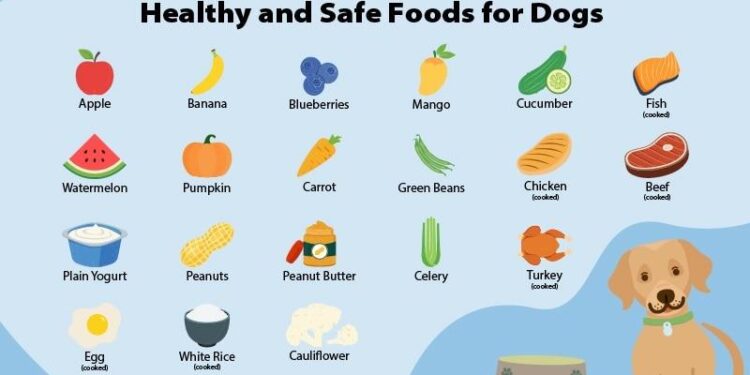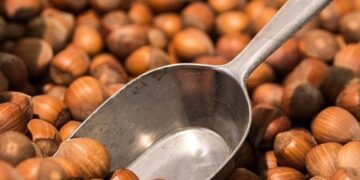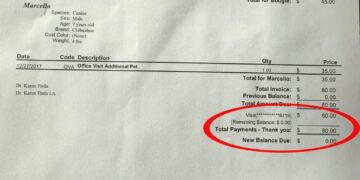Table of Contents
The day I brought Gus home, a fluffy, eight-pound ball of Golden Retriever sunshine, the world felt perfect.
I had done all the research, bought the best toys, and puppy-proofed every corner of my house.
I was ready.
Or so I thought.
That initial wave of pure joy quickly receded into a tide of anxiety, centered entirely on one simple object: his food bowl.
The breeder gave me a small bag of one brand, my vet recommended another, and the internet screamed a thousand conflicting opinions about grains, raw diets, and protein percentages.
I felt like I was drowning.
I picked a well-regarded, expensive brand and followed the instructions on the bag to the letter.
But Gus didn’t thrive.
His energy was low, his coat was dull, and he was plagued by persistent digestive issues.
We were in and out of the vet’s office, and with every visit, my confidence crumbled.
This wasn’t just a minor hiccup; it felt like a fundamental failure.
I was supposed to be building this perfect little creature into a strong, healthy dog, and instead, I was seeing cracks appear in his very foundation.
The breakthrough came from the most unexpected place.
I was venting my frustrations to an old friend, an architect, over coffee.
As he described the process of designing a new building, he talked about the immense effort that goes into the unseen parts—the soil analysis, the rebar calculations, the precise concrete mix for the foundation.
He said, “You can’t put up beautiful walls on a foundation that’s going to crack.
Everything depends on getting that first step absolutely right.”
A lightbulb didn’t just go off; it was like a stadium floodlight illuminated my entire problem.
I had been treating puppy feeding like a chore—scooping kibble into a bowl.
I should have been approaching it like an architectural project.
Feeding a puppy isn’t about filling their belly for the day; it is the meticulous, deliberate act of constructing the healthy adult dog they are destined to become.
This “Building a House” analogy became my new paradigm, a powerful framework that finally transformed my confusion into clarity.
And it’s this blueprint that I want to share with you, so you can build a magnificent, healthy life for your new companion, starting from this critical six-week mark.
Laying the Foundation: The Weaning Process & Gut Health
In any construction project, the most critical phase is pouring the foundation.
It’s not the most glamorous part—there are no walls or windows yet—but the integrity of the entire structure depends on it.
A rushed or poorly mixed foundation will compromise everything built upon it for the life of the building.
For your six-week-old puppy, the weaning process is that foundation.
At six weeks, your puppy is at the very heart of a monumental transition, moving from complete reliance on their mother’s milk to eating solid food.1
This process, which begins around three to four weeks of age and completes by about eight weeks, is not an overnight switch.4
It is a gradual, delicate adaptation that sets the stage for their entire future health.
The Gut Microbiome: Your Puppy’s Internal Construction Crew
To understand why this transition is so critical, we need to look deeper, at an internal ecosystem that scientists are now calling a “living organ”: the gut microbiome.7
This is a complex community of trillions of bacteria and other microorganisms living in your puppy’s digestive tract.
This “internal construction crew” is responsible for everything from digesting food and absorbing nutrients to developing a robust immune system and even producing essential vitamins.7
The weaning period is the primary colonization phase for this crew.
The shift from milk to solid food is what shapes this community, determining which bacteria will thrive and form a resilient, lifelong colony.
An abrupt dietary change is like a seismic shock to this delicate, developing ecosystem.
It can lead to dysbiosis—an imbalance in the gut flora—which doesn’t just cause temporary diarrhea or vomiting; it can lay a faulty foundation, potentially leading to chronic digestive issues, food sensitivities, allergies, and a weakened immune system for years to come.7
The meticulous, gradual process of weaning isn’t just about preventing an upset stomach; it is the very act of
architecting your puppy’s gut microbiome.
Mixing the Concrete: Preparing Puppy Gruel
At six weeks, a puppy’s digestive system is not ready for hard, dry kibble.
The “concrete” for their foundation must be a soft, porridge-like mixture often called “gruel” or “mush.” This eases the transition and allows their internal construction crew to adapt slowly.6
Creating this starter meal is simple:
- Choose a High-Quality Base: Start with the high-quality, AAFCO-approved puppy food (either kibble or canned) that you plan to feed them as they grow. Using the same food from the start minimizes dietary changes that can upset their system.4
- Soften and Mix:
- For Dry Kibble: Place the puppy’s meal portion in a bowl and add warm water or a puppy milk replacer (like Esbilac) until the kibble is covered. Let it soak until it becomes soft and mushy, then mash it with a fork into a porridge-like consistency.10
- For Canned Food: Mix the wet puppy food with a small amount of warm water or puppy milk replacer to create a smoother, more liquid gruel.5
- Serve Warm: The mixture should be served lukewarm. This not only makes it more palatable but also enhances the aroma, encouraging the puppy to try this new food.11
Offer this gruel in a shallow, heavy-bottomed dish to prevent tipping.
At first, your puppy might just walk in it or lick it off your finger, but they will quickly learn to lap it from the bowl.4
Over the next couple of weeks, you will gradually reduce the amount of liquid in the mixture, making it progressively thicker until, by around eight to ten weeks, they are eating the solid food on its own.5
This slow, deliberate process ensures the foundation of their health is poured perfectly, ready to support a lifetime of well-being.
Framing the Structure: The Macronutrient Blueprint
With a solid foundation poured, the next stage of construction is framing.
This is where the building takes shape, using load-bearing walls, structural beams, and electrical wiring to create a functional and resilient structure.
For your growing puppy, the macronutrients—protein, fat, and carbohydrates—are these essential framing materials.
Using the wrong blueprint or substandard materials at this stage will result in a weak, unstable, and dysfunctional structure.
A puppy’s blueprint is fundamentally different from an adult dog’s; they are building, not just maintaining.
Protein: The Load-Bearing Walls
Protein provides the essential amino acids that are the literal “bricks” for building new tissue.
During this period of explosive growth, puppies require significantly more protein than adult dogs to construct everything from strong muscles to healthy organs and a robust immune system.10
The nutritional standards set by the Association of American Feed Control Officials (AAFCO) reflect this.
The minimum protein requirement for growing puppies is 22.5% on a dry matter basis, a substantial increase from the 18% minimum required for adult maintenance.19
However, quantity is only half the story.
The quality of the protein—its biologic value—is paramount.
High-quality, animal-based proteins from sources like chicken, beef, lamb, and fish provide a complete amino acid profile that is highly digestible and readily used by your puppy’s body for construction.16
Fats & DHA: The Electrical Wiring and Smart Systems
Fat is the most concentrated source of energy in the diet, fueling the high-energy demands of a growing puppy.10
Just like a construction site needs a powerful and reliable electrical supply, a puppy needs ample fat to power the building process.
The AAFCO minimum for fat in puppy food is 8.5%, compared to just 5.5% for adult dogs.19
Within this category, one specific type of fat acts as the advanced “smart home wiring” for your puppy’s developing brain and nervous system: DHA (Docosahexaenoic acid).
This omega-3 fatty acid is a primary structural component of the brain and the retina of the eye.18
Puppies first receive DHA from their mother’s milk, but after weaning, their diet must supply this critical nutrient.18
The impact of DHA is not trivial.
Multiple studies have shown that puppies fed diets enriched with DHA demonstrate superior cognitive function, better memory, and improved retinal health.24
This means the choice of puppy food is not just a health decision; it is a direct investment in your dog’s future intelligence and behavior.
Providing adequate DHA is akin to installing high-quality wiring during construction.
A house can function with basic wiring, but one with advanced systems is more responsive, capable, and easier to interact with.
Similarly, a puppy raised on a DHA-rich diet is being neurologically primed for better learning and trainability, which can significantly reduce frustration during training and forge a stronger, more rewarding bond between you and your dog.24
Carbohydrates: The On-Site Power Generators
Carbohydrates from sources like whole grains, rice, or sweet potatoes serve as the readily accessible, on-site power generators for the construction project.
They provide the quick-burning fuel your puppy needs for their endless bouts of play and exploration.16
This is crucial because it allows the more specialized materials—protein and fat—to be used for their primary structural roles rather than being burned for immediate energy.
The profound difference in the nutritional blueprint for puppies and adults cannot be overstated.
Feeding an adult dog food to a six-week-old puppy is like trying to frame a skyscraper with the blueprints for a single-story home—it will inevitably lead to structural failure.
| Nutrient | AAFCO Puppy Minimum (Growth) | AAFCO Adult Minimum (Maintenance) | The Architectural Role |
| Protein | 22.5% (dry matter) | 18% (dry matter) | The “bricks” and “beams” for building muscle and tissue. |
| Fat | 8.5% (dry matter) | 5.5% (dry matter) | The primary energy source to power construction. |
| Calcium | 1.2% (dry matter) | 0.5% (dry matter) | The “rebar” needed for strong bone formation. |
| DHA | Recommended | Not required | The “smart wiring” for brain and vision development. |
Data sourced from.19
Installing the Utilities: Micronutrients and Essential Minerals
A house can be perfectly framed, but it’s uninhabitable without the essential utilities: the plumbing that carries water, the rebar that reinforces the concrete, and the fixtures that make it functional.
In your puppy’s body, micronutrients—vitamins and minerals—are these vital systems.
They are required in smaller quantities than macronutrients, but without them, the entire structure is unsound.
Calcium & Phosphorus: The Rebar in the Concrete
Calcium and phosphorus are the two most important minerals for skeletal development, working together to build strong bones and teeth.10
As the table above shows, puppies require more than double the minimum amount of calcium compared to adult dogs (1.2% vs. 0.5%) to support this rapid skeletal construction.19
However, the most critical factor is not the absolute amount of calcium, but its ratio to phosphorus.
This delicate balance is the key to healthy bone development.
The ideal calcium-to-phosphorus ratio in a puppy’s diet should be between 1.1:1 and 2:1.16
A high-quality, complete, and balanced puppy food is formulated to provide this precise ratio.
The Large Breed Caveat: The Goldilocks Principle of Calcium
For owners of large and giant breed puppies (like my Golden Retriever, Gus), this topic deserves special attention.
These breeds are uniquely sensitive to calcium imbalances.
For them, calcium operates on a “Goldilocks Principle”: too little is bad, too much is disastrous, but the amount must be just right.
In a well-intentioned effort to build strong bones, new owners sometimes make the catastrophic mistake of adding calcium supplements (like yogurt or cottage cheese) to their large breed puppy’s balanced diet.
This is like adding too much chemical hardener to a concrete mix; it doesn’t make it stronger, it makes it brittle and prone to cracking under stress.
Excessive calcium intake in a large breed puppy can disrupt normal bone development and is a significant risk factor for painful and debilitating developmental orthopedic diseases, such as hip dysplasia and osteochondrosis.26
This is why it is absolutely critical to never supplement calcium in a large breed puppy’s diet unless specifically directed by a veterinarian.17
Choosing a food specifically formulated for “large breed puppies” is not a marketing gimmick; it is a crucial safety measure to ensure the calcium and phosphorus levels are precisely controlled to promote a steady, healthy rate of growth, preventing lifelong skeletal problems.
Vitamins & Minerals: The Essential Fixtures and Fittings
Beyond calcium and phosphorus, a host of other vitamins and minerals are required to ensure all the “household systems” function correctly.
Vitamin A is essential for healthy vision, Vitamin E supports the immune system, and minerals like zinc and magnesium are crucial for skin health and hundreds of metabolic processes that keep the construction running smoothly.10
A food that carries the AAFCO statement for “complete and balanced nutrition” will contain all these essential fixtures in the correct amounts and proportions, eliminating any need for additional supplementation.
The Architect’s Plan: Food Selection & Feeding Schedules
Every successful construction project relies on a detailed set of plans.
The architect provides blueprints, a construction schedule, and conducts regular site inspections to ensure the project is proceeding correctly.
For your puppy, the food you choose is the blueprint, the feeding schedule is your timeline, and monitoring their progress is your ongoing site inspection.
Reading the Blueprints: How to Choose a Food
Navigating the pet food aisle can be overwhelming, but there is one simple “building permit” you must look for on every bag or can.
- The AAFCO Statement: This is the most important piece of information on the label. Look for the “nutritional adequacy statement,” which will certify that the food is “formulated to meet the nutritional levels established by the AAFCO Dog Food Nutrient Profiles for growth” or for “all life stages“.30 If it only says “maintenance,” it is an adult dog food and is not appropriate for your puppy. This statement is your guarantee that the blueprint is sound.
- Kibble vs. Wet Food: At six weeks, your puppy’s food will need to be softened into a gruel, so the initial form is less critical than the nutritional content. Both have their advantages.
- Wet (Canned) Food: Often more palatable for picky eaters, its soft texture is easy for weaning puppies to manage, and its high moisture content helps with hydration.14
- Dry Food (Kibble): More economical, convenient to store and measure, and its abrasive texture can help with dental health once the puppy is older and eating it dry.1
Many owners find that a combination of both works well, perhaps by mixing a spoonful of wet food into the softened kibble to enhance palatability.33 The key is that whichever you choose, it must be a high-quality, AAFCO-compliant
puppy formula. - Brand Considerations: While many brands can provide excellent nutrition, those that adhere to the World Small Animal Veterinary Association (WSAVA) guidelines are often recommended by veterinarians because they employ full-time veterinary nutritionists and conduct extensive research and feeding trials. Brands like Purina Pro Plan, Hill’s Science Diet, Royal Canin, and Eukanuba are consistently cited as meeting these high standards.30 Some, like Royal Canin, even offer a “Starter” formula specifically designed for the weaning period.30
The Construction Schedule: How Often and How Much
- Frequency: A six-week-old puppy has a tiny stomach but a furnace of a metabolism. To provide a steady supply of energy and nutrients without overwhelming their digestive system, they need frequent, small meals. The veterinary consensus is to feed them four times per day.1 This schedule helps prevent hypoglycemia (a dangerous drop in blood sugar), which is a particular risk for toy and small breeds.10
- Quantity: The exact amount of food depends on your puppy’s current weight, their breed, and the calorie content of the specific food you’ve chosen. The feeding chart on the package is your starting point.3
- Find your puppy’s current weight and age on the chart to determine the total recommended daily amount.
- Divide that total amount by four to get the portion size for each meal.
- Use a measuring cup or kitchen scale for accuracy. Overfeeding is a common and dangerous mistake.37
| Time | Meal | Notes |
| 7:00 AM | Breakfast | Serve a quarter of the total daily portion as a warm, soft gruel. |
| 12:00 PM | Lunch | Another quarter portion. A consistent schedule helps regulate digestion and aids in house-training. |
| 4:00 PM | Afternoon Meal | A third quarter portion. Monitor their appetite and body condition. |
| 8:00 PM | Dinner | The final quarter portion. This meal prevents them from getting too hungry overnight. |
This sample schedule 10 establishes the routine that is critical for both physical and behavioral development.
Site Inspections: Monitoring Your Puppy’s Progress
As the architect of your puppy’s health, you need to conduct regular “site inspections” to ensure the build is on track.
The two best indicators are their body condition and their stool quality.
- Body Condition: A healthy puppy should be lean and well-proportioned. While they have some “puppy pudginess,” they should not be roly-poly. You should be able to feel their ribs easily without them being prominent. By 12 weeks, they should start to lose their potbelly.1 A lean body condition throughout puppyhood is one of the best ways to protect their developing joints, especially in large breeds.29
- Stool Quality: What comes out is a direct indicator of what’s happening inside. A healthy puppy stool should be firm, well-formed, and consistent. Persistent diarrhea or very soft stools can be a sign that the food isn’t being digested well or that the transition was too quick.6
Avoiding Construction Disasters: Common Mistakes & Known Hazards
Even the best architectural plan can be ruined by on-site mistakes or unforeseen hazards.
This final section is your project’s safety manual, designed to help you avoid the common pitfalls that can derail your puppy’s healthy development.
The Peril of a Rushed Job: Gradual Food Transitions
If you need to change your puppy’s food for any reason—whether transitioning from the breeder’s choice or switching formulas—it is absolutely critical that you do it slowly.
An abrupt change is one of the most common causes of digestive upset (vomiting and diarrhea) because it sends a shockwave through their developing gut microbiome.9
The proper procedure is a gradual transition over a period of 7 to 10 days.
| The 7-Day Food Transition Plan |
| Days 1-2: Mix 75% old food with 25% new food. |
| Days 3-4: Mix 50% old food with 50% new food. |
| Days 5-6: Mix 25% old food with 75% new food. |
| Day 7+: Feed 100% new food. |
This gradual schedule 39 allows the digestive system and gut flora to adapt, preventing unnecessary distress.
Unapproved Building Materials: Toxic Human Foods
Your home is full of “building materials” that are perfectly safe for you but highly toxic to your puppy.
Their curious nature makes them prone to sampling things they shouldn’t, so vigilance is key.
| High-Alert Toxins for Puppies |
| Xylitol |
| Grapes & Raisins |
| Chocolate |
| Onions, Garlic, Chives |
| Macadamia Nuts |
This is not an exhaustive list.
Always consult your veterinarian before sharing any human food.42
Five Foundational Flaws: Common Owner Mistakes
Beyond specific hazards, several common behavioral mistakes can undermine your puppy’s health.
- Overfeeding: The belief that “a chubby puppy is a healthy puppy” is a dangerous myth. Overfeeding puts immense strain on developing bones and joints and is a primary risk factor for orthopedic problems and lifelong obesity.29 Stick to measured portions.
- Inconsistent Schedules: Free-feeding (leaving food out all day) or feeding at random times makes it impossible to monitor their intake, disrupts their digestive rhythm, and severely complicates house-training.37 Routine is paramount.
- Feeding Adult Food Too Soon: As detailed earlier, this starves your puppy of the critical building blocks they need for growth and is one of the most damaging nutritional mistakes an owner can make.1
- Ignoring Hydration: Puppies have a higher metabolic rate and are more prone to dehydration than adult dogs. A bowl of fresh, clean water must always be available.10
- Too Many Treats: Training treats are essential, but they contain calories. Treats and other snacks should make up no more than 10% of your puppy’s total daily caloric intake. Exceeding this can unbalance their carefully formulated diet and lead to weight gain.17
A Home Built to Last
Looking back at those first agonizing weeks with Gus, I see my mistake so clearly now.
I was just looking at the bowl, not at the blueprint.
Once I embraced the mindset of an architect—understanding that every single meal was a deliberate act of construction—everything changed.
I switched Gus to a high-quality, large-breed puppy formula, meticulously measured his four daily meals of warm gruel, and followed the architectural principles I had learned.
The transformation was remarkable.
Within weeks, his digestion normalized.
His coat, once dull and patchy, grew in thick and glossy.
His energy levels soared, and the lethargic, uncomfortable puppy was replaced by the boisterous, joyful companion I had always dreamed of.
The care, precision, and knowledge you invest in your puppy’s nutrition during these first few critical weeks is the greatest gift you can give them.
You are not just feeding a puppy.
You are laying a foundation, framing a structure, and installing the systems for a lifetime of health.
You are the architect of their well-being.
By following this blueprint, you can ensure that the beautiful “house” you are building together is a magnificent home, built to last.
Works cited
- Puppy Feeding Fundamentals: Timeline for Puppy Feeding, accessed August 16, 2025, https://www.akc.org/expert-advice/nutrition/puppy-feeding-fundamentals/
- How to Properly Feed a Puppy | Wellness Pet Food, accessed August 16, 2025, https://www.wellnesspetfood.com/blog/blog-how-to-properly-feed-a-puppy/
- Creating a puppy feeding schedule – Care.com, accessed August 16, 2025, https://www.care.com/c/creating-a-puppy-feeding-schedule/
- poodleandpoochrescue.org, accessed August 16, 2025, https://poodleandpoochrescue.org/pdf/Weaning_Puppies_PPR_Guide.pdf
- When Can Puppies Eat Solid Food? What To Know about Weaning Puppies – PetMD, accessed August 16, 2025, https://www.petmd.com/dog/nutrition/when-can-puppies-eat-solid-food
- How do I transition puppies from formula to solid food? – American Breeder, accessed August 16, 2025, https://www.americanbreeder.com/resources/american-breeder-blog/dogs/puppy-weaning-formula-to-solid-food
- Gut microbiota development in the growing dog: A dynamic process influenced by maternal, environmental and host factors, accessed August 16, 2025, https://pmc.ncbi.nlm.nih.gov/articles/PMC9478664/
- The Role of the Canine Gut Microbiome and Metabolome in Health and Gastrointestinal Disease – Frontiers, accessed August 16, 2025, https://www.frontiersin.org/journals/veterinary-science/articles/10.3389/fvets.2019.00498/full
- Changing Puppy/Dog Food Too Quickly | Symptoms & Vet Tips – Beco, accessed August 16, 2025, https://www.becopets.com/blogs/news/changing-puppy-food-too-quickly-symptoms
- How Often to Feed 6 Week Old Puppy: A Guide to Optimal Nutrition …, accessed August 16, 2025, https://www.houndsy.com/blogs/modern-tails/how-often-to-feed-6-week-old-puppy-a-guide-to-optimal-nutrition-and-care
- Transitioning Kittens and Puppies to Solid Food, accessed August 16, 2025, https://www.maddiesfund.org/transitioning-kittens-and-puppies-to-solid-food/presentation_content/external_files/Educational%20Handout-%20Transitioning%20Kittens%20and%20Puppies%20to%20Solid%20Food.pdf
- Weaning Puppies Off Their Mother – Breeding Tips – Highland Pet Hospital, accessed August 16, 2025, https://www.highlandpethospital.net/weaning-and-sale/
- How to make puppy mush or gruel for 22 days old puppies? To start weaning them – Petco, accessed August 16, 2025, https://www.petco.com/content/content-hub/home/questions/01/5/476978.html
- When to Start Feeding Puppies Wet Food | Purina US, accessed August 16, 2025, https://www.purina.com/articles/dog/puppy/feeding/when-to-start-feeding-puppies-wet-food
- Puppy Gruel Recipe – Southern Pines Animal Shelter, accessed August 16, 2025, https://www.southernpinesanimalshelter.org/uploads/5/1/7/5/51753035/puppy_gruel_recipe.pdf
- Aussie Guide: Nutritional Requirement for Puppies – Zach’s Pet Shop, accessed August 16, 2025, https://zachspetshop.com.au/blogs/guides-advice/nutritional-requirement-for-puppies
- Feeding Growing Puppies | VCA Animal Hospitals, accessed August 16, 2025, https://vcahospitals.com/know-your-pet/feeding-growing-puppies
- Your Puppy’s Diet & Nutritional Needs – Purina, accessed August 16, 2025, https://www.purina.com/articles/dog/puppy/feeding/diet-and-nutritional-needs
- Puppy Food vs. Adult Dog Food: What’s the Difference? | Purina US, accessed August 16, 2025, https://www.purina.com/articles/dog/puppy/feeding/puppy-food-vs-adult-dog-food
- How Does Nutrition for Puppies Differ From Nutrition for Adult Dogs? – Ollie Blog, accessed August 16, 2025, https://blog.myollie.com/how-does-nutrition-for-puppies-differ-from-nutrition-for-adult-dogs-2/
- Nutritional Requirements of Small Animals – Merck Veterinary Manual, accessed August 16, 2025, https://www.merckvetmanual.com/management-and-nutrition/nutrition-small-animals/nutritional-requirements-of-small-animals
- Puppy Nutrition 101 – My Pet Nutritionist, accessed August 16, 2025, https://mypetnutritionist.com/post/puppy-nutrition-101/
- A to Z of Pet Food: Growth, accessed August 16, 2025, https://www.petfoodinstitute.org/a-to-z-of-pet-food-growth/
- DHA for puppies – Royal Canin Academy, accessed August 16, 2025, https://academy.royalcanin.com/en/veterinary/dha-for-puppies
- Dogs & Diets: 5 Nutrients Your Dog Needs to Stay Healthy – NutriFusion, accessed August 16, 2025, https://nutrifusion.com/nutrients-your-dog-needs-for-good-health/
- Giant Expectations: Nutrition for the Large-Breed Puppy – Today’s Veterinary Nurse, accessed August 16, 2025, https://todaysveterinarynurse.com/nutrition/nutrition-for-the-large-breed-puppy/
- Nutritional Guidelines – FEDIAF, accessed August 16, 2025, https://europeanpetfood.org/wp-content/uploads/2022/03/Updated-Nutritional-Guidelines.pdf
- Nutritional Considerations for Large and Giant Breed Dogs | VCA Animal Hospitals, accessed August 16, 2025, https://vcahospitals.com/know-your-pet/nutritional-considerations-for-large-and-giant-breed-dogs
- Proper Puppy Nutrition Nourishes Rapid Growth & Development – American Kennel Club, accessed August 16, 2025, https://www.akc.org/expert-advice/health/proper-puppy-nutrition-nourishes-rapid-growth/
- The 8 Best Puppy Foods in 2025 Recommended by Vets – PetMD, accessed August 16, 2025, https://www.petmd.com/dog/vet-verified/best-puppy-food
- What Should I Feed My Puppy? Nutrition, Portion & Dietary Needs – Rover.com, accessed August 16, 2025, https://www.rover.com/blog/puppy-nutrition-basics/
- Do Puppies Need Wet Food? A Guide to Puppy Nutrition – Zach’s Pet Shop, accessed August 16, 2025, https://zachspetshop.com.au/blogs/guides-advice/do-puppies-need-wet-food
- Wet, Dry or Mixed Puppy Food?, accessed August 16, 2025, https://www.mypedigree.ca/en-ca/our-help-hub/puppy/feeding-my-puppy/wet-dry-or-mixed-puppy-food
- Wet Dog Food vs Dry dog food: What’s Best? | Pooch & Mutt, accessed August 16, 2025, https://www.poochandmutt.co.uk/blogs/nutrition/to-feed-wet-or-dry-dog-food
- Dry, Canned, or Semi-Moist: Food Choices for Dogs – VCA Animal Hospitals, accessed August 16, 2025, https://vcahospitals.com/know-your-pet/dry-canned-or-semimoist-food-choices-for-dogs
- What is the consensus on the best puppy food? : r/puppy101 – Reddit, accessed August 16, 2025, https://www.reddit.com/r/puppy101/comments/1it4xtj/what_is_the_consensus_on_the_best_puppy_food/
- Common Dog Feeding Mistakes and How to Avoid Them – The Pets Table Blog, accessed August 16, 2025, https://blog.thepetstable.com/common-dog-feeding-mistakes-and-how-to-avoid-them/
- Growth Guide: Keeping your Puppy on the Right Track – Petfoodology – Tufts Sites, accessed August 16, 2025, https://sites.tufts.edu/petfoodology/2022/01/31/growth-guide-keeping-your-puppy-on-the-right-track/
- Changing Dog Food for Your New Pup – Hill’s Pet Nutrition, accessed August 16, 2025, https://www.hillspet.com/dog-care/nutrition-feeding/effects-of-changing-new-dogs-food
- A Dog’s Gastrointestinal Response to Dietary Changes – Natural Farm, accessed August 16, 2025, https://www.naturalfarmpet.com/blogs/all/a-dogs-gastrointestinal-response-to-dietary-changes
- 30 Foods Poisonous to Dogs – GoodRx, accessed August 16, 2025, https://www.goodrx.com/pet-health/dog/what-foods-are-poisonous-to-dogs
- Plants and foods that can be poisonous to pets | Humane World for Animals, accessed August 16, 2025, https://www.humaneworld.org/en/resources/plants-and-foods-can-be-poisonous-pets
- Five Common Mistakes When Feeding Puppies | Dog Food Advisor, accessed August 16, 2025, https://www.dogfoodadvisor.com/dog-feeding-tips/common-feeding-mistakes-with-puppies/
- 15 Deadly Mistakes You’re Making When Feeding Your Dog – YouTube, accessed August 16, 2025, https://www.youtube.com/watch?v=TI0CbxUp9OE






